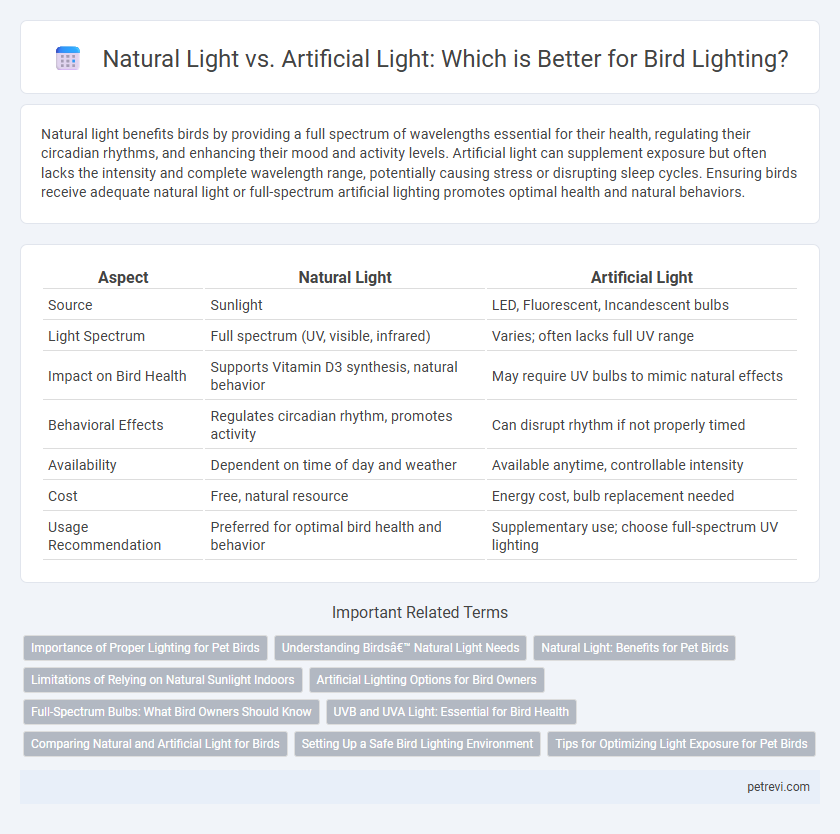Natural light benefits birds by providing a full spectrum of wavelengths essential for their health, regulating their circadian rhythms, and enhancing their mood and activity levels. Artificial light can supplement exposure but often lacks the intensity and complete wavelength range, potentially causing stress or disrupting sleep cycles. Ensuring birds receive adequate natural light or full-spectrum artificial lighting promotes optimal health and natural behaviors.
Table of Comparison
| Aspect | Natural Light | Artificial Light |
|---|---|---|
| Source | Sunlight | LED, Fluorescent, Incandescent bulbs |
| Light Spectrum | Full spectrum (UV, visible, infrared) | Varies; often lacks full UV range |
| Impact on Bird Health | Supports Vitamin D3 synthesis, natural behavior | May require UV bulbs to mimic natural effects |
| Behavioral Effects | Regulates circadian rhythm, promotes activity | Can disrupt rhythm if not properly timed |
| Availability | Dependent on time of day and weather | Available anytime, controllable intensity |
| Cost | Free, natural resource | Energy cost, bulb replacement needed |
| Usage Recommendation | Preferred for optimal bird health and behavior | Supplementary use; choose full-spectrum UV lighting |
Importance of Proper Lighting for Pet Birds
Proper lighting is essential for pet birds as it influences their circadian rhythms, hormone production, and overall health. Natural light provides the full spectrum of UV rays necessary for vitamin D synthesis, aiding in calcium absorption and bone strength. Artificial lighting that mimics natural light spectra can support a bird's wellbeing indoors, preventing behavioral issues and promoting feather quality.
Understanding Birds’ Natural Light Needs
Birds rely on natural light cycles to regulate their circadian rhythms, which affect their feeding, breeding, and migratory behaviors. Natural light contains a full spectrum of wavelengths essential for Vitamin D synthesis and overall health in birds. Artificial lighting often lacks the intensity and spectrum of sunlight, potentially disrupting birds' natural biological processes and causing stress or behavioral issues.
Natural Light: Benefits for Pet Birds
Natural light provides pet birds with essential ultraviolet (UV) rays that support vitamin D synthesis, promoting calcium absorption and bone health. Exposure to natural light helps regulate circadian rhythms, leading to improved mood, behavior, and overall well-being in birds. Unlike artificial light, natural light offers a full spectrum of wavelengths that better mimic a bird's natural environment, encouraging natural behaviors and enhancing feather condition.
Limitations of Relying on Natural Sunlight Indoors
Relying solely on natural sunlight indoors poses limitations such as inconsistent light exposure due to weather fluctuations and seasonal changes, which can affect a bird's circadian rhythm and vitamin D synthesis. Indoor environments often block essential ultraviolet (UV) rays necessary for calcium metabolism and overall health, leading to potential deficiencies. Supplementing with artificial full-spectrum lighting ensures birds receive balanced light intensity and UV radiation regardless of outdoor conditions.
Artificial Lighting Options for Bird Owners
Artificial lighting options for bird owners include full-spectrum LED lights, which mimic natural sunlight and promote healthy circadian rhythms. UVB bulbs are essential for vitamin D synthesis, supporting calcium metabolism and bone health in birds. Adjustable timers and dimmable features help simulate dawn and dusk, reducing stress and encouraging natural behaviors in captive birds.
Full-Spectrum Bulbs: What Bird Owners Should Know
Full-spectrum bulbs mimic natural sunlight by providing a balanced light spectrum essential for a bird's health, supporting vitamin D synthesis and regulating circadian rhythms. Natural light offers the full range of ultraviolet rays vital for feather quality and behavioral stimulation, whereas artificial lighting often lacks UVB rays unless specifically designed as full-spectrum. Bird owners should choose full-spectrum bulbs certified to emit UVB and UVA radiation to promote optimal bird well-being and prevent deficiencies related to inadequate lighting.
UVB and UVA Light: Essential for Bird Health
Birds require both UVB and UVA light to maintain optimal health, as UVB rays enable vitamin D3 synthesis crucial for calcium metabolism and bone strength. Natural sunlight provides the full spectrum of UVA and UVB, promoting vibrant plumage, behavior stimulation, and overall well-being. Artificial bird lights with balanced UVB and UVA wavelengths serve as vital supplements in indoor aviaries, supporting immune function and preventing metabolic bone disease.
Comparing Natural and Artificial Light for Birds
Natural light provides birds with a full spectrum of wavelengths essential for regulating their circadian rhythms, enhancing vitamin D synthesis, and supporting overall health and behavior. Artificial light often lacks this full spectrum, potentially disrupting birds' biological cycles and causing stress or abnormal behaviors if not properly balanced with natural lighting conditions. Controlled use of full-spectrum artificial lighting can supplement natural light but cannot fully replace the benefits of direct sunlight exposure for avian well-being.
Setting Up a Safe Bird Lighting Environment
Natural light provides birds with essential UV rays that regulate their circadian rhythms and support vitamin D synthesis, crucial for bone health and feather quality. Artificial lighting should mimic the natural light spectrum and maintain consistent photoperiods to prevent stress and behavioral issues in birds. Position lighting sources to avoid direct glare and overheating, ensuring a safe and comfortable environment that promotes overall well-being and natural activity patterns.
Tips for Optimizing Light Exposure for Pet Birds
Natural light provides the full spectrum of wavelengths essential for bird health and behavior, supporting vitamin D synthesis and circadian rhythm regulation. Artificial light sources should mimic natural sunlight with full-spectrum bulbs that include UVB rays to enhance feather quality and calcium metabolism. Position bird cages near windows to maximize daytime natural light exposure while using adjustable timers on artificial lights to maintain consistent light cycles crucial for pet birds' well-being.
Natural Light vs Artificial Light for Bird Lighting Infographic

 petrevi.com
petrevi.com